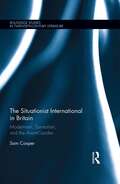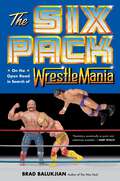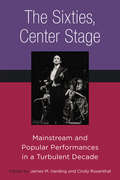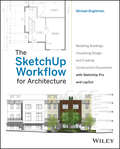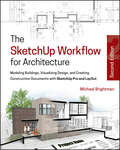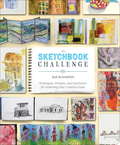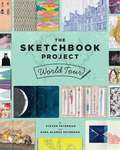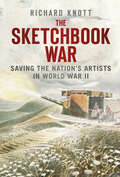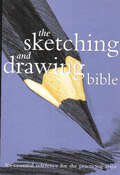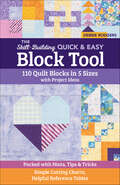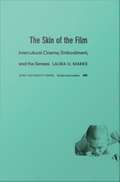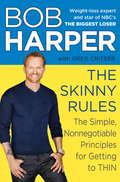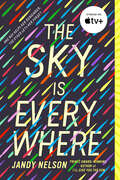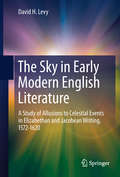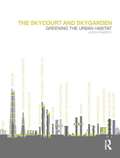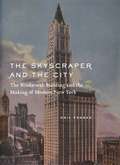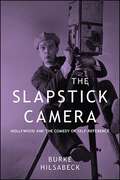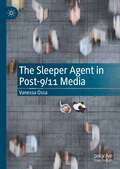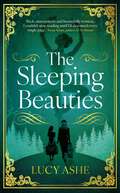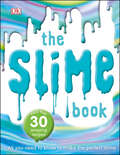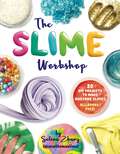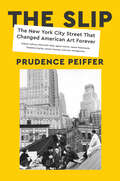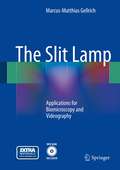- Table View
- List View
The Situationist International in Britain: Modernism, Surrealism, and the Avant-Garde (Routledge Studies in Twentieth-Century Literature)
by Sam CooperThis book tells, for the first time, the story of the Situationist International’s influence and afterlives in Britain, where its radical ideas have been rapturously welcomed and fiercely resisted. The Situationist International presented itself as the culmination of the twentieth century avant-garde tradition — as the true successor of Dada and Surrealism. Its grand ambition was not unfounded. Though it dissolved in 1972, generations of artists and writers, theorists and provocateurs, punks and psychogeographers have continued its effort to confront and contest the ‘society of the spectacle.’ This book constructs a long cultural history, beginning in the interwar period with the arrival of Surrealism to Britain, moving through the countercultures of the 1950s and 1960s, and finally surveying the directions in which Situationist theory and practice are being taken today. It combines agile historicism with close readings of a vast range of archival and newly excavated materials, including newspaper reports, underground pamphlets, Psychogeographical films, and experimental novels. It brings to light an overlooked but ferociously productive period of British avant-garde practice, and demonstrates how this subterranean activity helps us to understand postwar culture, late modernism, and the complex internationalization of the avant-garde. As popular and academic interest in the Situationists grows, this book offers an important contribution to the international history of the avant-garde and Surrealism. It will prove a valuable resource for researchers and students of English and Comparative Literature, Modernism and the Avant-Gardes, Twentieth Century and Contemporary History, Cultural Studies, Art History, and Political Aesthetics.
The Six Pack: On the Open Road in Search of Wrestlemania
by Brad BalukjianFrom the bestselling author of The Wax Pack, comes another eye‑opening road trip adventure into a pocket of iconic pop culture—professional wrestling—starring the Iron Sheik, Hulk Hogan, Tito Santana, and many more larger‑than‑life characters of the WWF in the 1980s. "Perhaps one of the most truthful and enjoyable reads about my profession ever. I absolutely loved this book." —Former WWF Champion Bret "The Hitman" Hart In 2005, Brad Balukjian left his position as a magazine fact-checker to pursue a dream job: partner with his childhood hero, The Iron Sheik (whose real name was Khosrow Vaziri), to write his biography. Things quickly went south, culminating in the Sheik threatening Balukjian&’s life. Now seventeen years later, Balukjian returns to the road in search of not only a reunion with the Sheik, but something much bigger: truth in a world built on illusion. Balukjian seeks out six of the Sheik&’s contemporaries, fellow witnesses to the World Wrestling Federation&’s (WWF) explosion in the mid-&‘80s, to unearth their true identities. As Balukjian drives 12,525 miles around the country, we revisit the heady days when these avatars of strength, villainy, and heroism first found fame and see where their journeys took them. From working out with Tony Atlas (Tony White) to visiting Hulk Hogan&’s (Terry Bollea) karaoke bar, we see where these men are now and how they have navigated the cliffs of fame.The Six Pack combines the spirit of a fan with the rigor of an investigative reporter, tracking down former WWF employees, childhood friends, and mutually curious archivists. Wrestling is perceived as a subculture without a cultural home, somewhere between sport and theater—often dismissed as silly and low‑brow. But what makes this book so compelling is the humanity beneath each wrestler. The Iron Sheik, Hulk Hogan, and the rest of the cast were not characters in a comic book movie. They were real people, with families and feelings and bodies that could break. Most of them did, in fact, break; some have been repaired, but none of them will ever be the same.
The Sixties, Center Stage: Mainstream and Popular Performances in a Turbulent Decade
by James M. Harding Cindy RosenthalThe Sixties, Center Stage offers rich insights into the innovative and provocative political underpinnings of mainstream and popular performances in the 1960s. While much critical attention has been focused on experimental and radical theater of the period, the essays confirm that mainstream performances not only merit more scholarly attention than they have received, but through serious examination provide an important key to understanding the 1960s as a period. The introduction provides a broad overview of the social, political, and cultural contexts of artistic practices in mainstream theater from the mid-fifties to mid-seventies. Readers will find detailed examinations of the mainstream’s surprising attention to craft and innovation; to the rich exchange between European and American theatres; to the rise of regional theaters; and finally, to popular cultural performances that pushed the conceptual boundaries of mainstream institutions. The book looks afresh at productions of Hair, Cabaret, Raisin in the Sun, and Fiddler on the Roof, as well as German theater, and performances outside the Democratic National Convention of 1968.
The Sixty-Eight Rooms (The Sixty-Eight Rooms Adventures #1)
by Marianne MaloneRuthie thinks nothing exciting will ever happen to her until her sixth-grade class visits the Art Institute of Chicago, where she and her best friend Jack discover a magic key that shrinks them to the size of gerbils and allows them to explore the Thorne Room, which houses miniature rooms from various time periods and places.
The SketchUp Workflow for Architecture
by Michael BrightmanIncorporate SketchUp into every phase of your designIf you want to go beyond the basics and start using SketchUp 3D modeling software in all phases of your design, The SketchUp Workflow for Architecture is the perfect place to start. From preliminary schematics to construction documentation and everything in between, the book sketches out a workflow that is flexible enough to use from start to finish. You'll discover helpful techniques, smart tips, and best practices that will make your design process easier, as well as helping you easily export your models into BIM programs.The book includes in-depth coverage of the lightly-documented LayOut toolset and video tutorials on more advanced methods.Goes beyond the basics into intermediate and advanced techniques for architects, designers, and engineers who want to use SketchUp in all stages of designGuides you from basic schematics through design development to construction documentationIncludes best practices for organizing projects and workflows and helpful tipsProvides special coverage of the LayOut toolset, an often-underused component of SketchUp ProThe SketchUp Workflow for Architecture is a valuable addition to your design toolkit.
The SketchUp Workflow for Architecture: Modeling Buildings, Visualizing Design, and Creating Construction Documents with SketchUp Pro and LayOut
by Michael BrightmanA guide for leveraging SketchUp for any project size, type, or style. New construction or renovation. The revised and updated second edition of The SketchUp Workflow for Architecture offers guidelines for taking SketchUp to the next level in order to incorporate it into every phase of the architectural design process. The text walks through each step of the SketchUp process from the early stages of schematic design and model organization for both renovation and new construction projects to final documentation and shows how to maximize the LayOut toolset for drafting and presentations. Written by a noted expert in the field, the text is filled with tips and techniques to access the power of SketchUp and its related suite of tools. The book presents a flexible workflow method that helps to make common design tasks easier and gives users the information needed to incorporate varying degrees of SketchUp into their design process. Filled with best practices for organizing projects and drafting schematics, this resource also includes suggestions for working with LayOut, an underused but valuable component of SketchUp Pro. In addition, tutorial videos compliment the text and clearly demonstrate more advanced methods. This important text: Presents intermediate and advanced techniques for architects who want to use SketchUp in all stages of the design process Includes in-depth explanations on using the LayOut tool set that contains example plans, details, sections, presentations, and other information Updates the first edition to reflect the changes to SketchUp 2018 and the core functionalities, menus, tools, inferences, arc tools, reporting, and much more Written by a SketchUp authorized trainer who has an active online platform and extensive connections within the SketchUp community Contains accompanying tutorial videos that demonstrate some of the more advanced SketchUp tips and tricks Written for professional architects, as well as professionals in interior design and landscape architecture, The SketchUp Workflow for Architecture offers a revised and updated resource for using SketchUp in all aspects of the architectural design process.
The Sketchbook Challenge: Techniques, Prompts, and Inspiration for Achieving Your Creative Goals
by Sue BleiweissHave you ever bought a new sketchbook, opened to the first page, and thought, "Now what do I do?" Sue Bleiweiss and the talented minds behind The Sketchbook Challenge are here to help. Imagine a supportive community of artists sharing the innermost pages of their sketchbooks and offering you tips and techniques for overcoming creative blocks. That's what The Sketchbook Challenge is all about, and the popular blog of the same name has already inspired thousands. Inside this book, you'll find: · Themes that will motivate you to start your sketchbook--and, more important, keep at it · Tutorials spotlighting such mixed-media techniques as thread sketching, painted papers for collage, digital printing, and much more · Strategies to get off the sketchbook page and start creating inspired art--whether you're into painting, collage, fiber art, or beyond. · In-depth profiles of artists who have taken the Sketchbook Challenge and used it as a launching pad for their own meaningful artwork
The Sketchbook Project World Tour
by Steven Peterman Shane ZuckerDestined to go down as one of the era's most astonishing global art projects, the Brooklyn Art Library's Sketchbook Project has, in less than a decade, amassed more than thirty thousand sketchbooks submitted by people of all ages and artistic abilities from more than 130 countries. Bursting with color, vivid imagery, and bouts of whimsy mixed with deeply intimate insights, the sketchbooks capture the texture of personal experience in a dizzying variety of illustrative styles and layouts that run the gamut from street portraits to stream-of-consciousness doodles, comics, and pop-ups. The Sketchbook Project World Tour presents the most compelling, surprising, and visually stunning examples from this one-of-a-kind artistic treasury.
The Sketchbook War: Saving the Nation's Artists in World War II
by Richard KnottDuring the Second World War, British artists produced over 6,000 works of war art, the result of a government scheme partly designed to prevent the artists being killed. This book tells the story of nine courageous war artists who ventured closer to the front line than any others in their profession.Edward Ardizzone, Edward Bawden, Barnett Freedman, Anthony Gross, Thomas Hennell, Eric Ravilious, Albert Richards, Richard Seddon and John Worsley all travelled abroad into the dangers of war to chronicle events by painting them. They formed a close bond, yet two were torpedoed, two were taken prisoner and three died, two in 1945 when peacetime was at hand. Men who had previously made a comfortable living painting in studios were transformed by military uniforms and experiences that were to shape the rest of their lives, and their work significantly influenced the way in which we view war today.Portraying how war and art came together in a moving and dramatic way, and incorporating vivid examples of their paintings, this is the true story behind the war artists who fought, lived and died for their art on the front line of the Second World War.
The Sketching and Drawing Bible: An Essential Reference for the Practicing Artist (Artist's Bibles Ser.)
by Marylin ScottAn essential and extensively illustrated reference for the practical artist, covering materials, techniques, and subjects.This complete guide to drawing media, from pencils and charcoal to pastels and colored inks, also features:Information on how to achieve exciting and unusual effects by combining two or more drawing mediaOver 100 step-by-step demonstrations showing ways of tackling tricky subjectsSections covering figure, landscape, nature, urban, and still life drawingTips on how to professionally present your work and get it into the marketplace
The Skill-Building Quick & Easy Block Tool: 110 Quilt Blocks in 5 Sizes with Project Ideas; Packed with Hints, Tips & Tricks; Simple Cutting Charts, Helpful Reference Tables (Reference Guide Ser.)
by Debbie RodgersThe ultimate no-math block reference for quilters Ultra-portable and indispensable, this reference tool keeps the cutting instructions at your fingertips with more blocks, more diagrams, and more practical tips. No quilter should be without the essential toolkit that makes up the block tool, featuring dozens of precut-friendly designs and a complete block index, plus convenient rotary-cutting charts and reference tables. Exploded block diagrams and repeated layouts make construction a breeze. As a bonus, you’ll learn how to sew an accurate ¼” seam and create half-square triangles and flying geese blocks with ease. 110 traditional blocks in 5 sizes each, with design tips, diagrams, and color inspiration New, easy-to-use size with handy reference tables, rotary-cutting charts, and a block index Projects included for each block, or design your own!
The Skin of the Film: Intercultural Cinema, Embodiment, and the Senses
by Laura U. MarksMemories that evoke the physical awareness of touch, smell, and bodily presence can be vital links to home for people living in diaspora from their culture of origin. How can filmmakers working between cultures use cinema, a visual medium, to transmit that physical sense of place and culture? In The Skin of the Film Laura U. Marks offers an answer, building on the theories of Gilles Deleuze and others to explain how and why intercultural cinema represents embodied experience in a postcolonial, transnational world. Much of intercultural cinema, Marks argues, has its origin in silence, in the gaps left by recorded history. Filmmakers seeking to represent their native cultures have had to develop new forms of cinematic expression. Marks offers a theory of "haptic visuality"--a visuality that functions like the sense of touch by triggering physical memories of smell, touch, and taste--to explain the newfound ways in which intercultural cinema engages the viewer bodily to convey cultural experience and memory. Using close to two hundred examples of intercultural film and video, she shows how the image allows viewers to experience cinema as a physical and multisensory embodiment of culture, not just as a visual representation of experience. Finally, this book offers a guide to many hard-to-find works of independent film and video made by Third World diasporic filmmakers now living in the United States, Great Britain, and Canada. The Skin of the Film draws on phenomenology, postcolonial and feminist theory, anthropology, and cognitive science. It will be essential reading for those interested in film theory, experimental cinema, the experience of diaspora, and the role of the sensuous in culture.
The Skinny Rules: The Simple, Nonnegotiable Principles for Getting to Thin (Skinny Rules)
by Greg Critser Bob HarperWith so much conflicting weight-loss advice out there to confuse your efforts, it's no wonder you haven't been successful losing weight and keeping it off. But with Bob Harper, superstar trainer and co-host of NBC's hit show The Biggest Loser as your personal authority and coach, you can and will finally shed the pounds--whether you want to lose two or two hundred! Distilling Bob's vast knowledge of nutrition, weight-loss strategy, and human nature down to twenty simple, nonnegotiable principles, The Skinny Rules will help you step away from a reliance on processed foods and the need for so much sweet and salt and step into a newly thin lifestyle. And Bob's methods couldn't be more straightforward. Taking the guesswork out of implementing the Skinny Rules, Bob offers a month's worth of menu plans and more than 90 delicious, rule-abiding recipes for breakfast, lunch, dinner, and snacks to keep you cooking and eating skinny for life. You'll be happily astounded to see the variety and volume of the tasty food on your plate! He also includes terrific tips for what to stock in your fridge and what to prepare every weekend in order to set yourself up for success during your too-busy-to-cook weekdays. A virtual GPS to your weight-loss goals, The Skinny Rules takes the mystery out of the process, offering the fastest route to your skinny destination. LOSING WEIGHT IS NOW AS SIMPLE AS 1-2-3 . . . AND 3-15-18-20 TOO! Rule #3: Eat protein at every meal, making some kind of fish your go-to protein as often as you can. Take your weight and divide it by two--that's more or less how much protein you should be eating in grams every day. Rule #15: Eat at least ten meals a week at home (and cook them yourself). Restaurant portions are usually 40 to 50 percent bigger than what you'd serve at home--the more you eat out, the more you overeat. Set yourself up for success by preparing my turkey meatballs, hummus, and roasted vegetables on the weekend so that you will have go-to staples and no excuses! Rule #18: Go to bed slightly hungry. Denied fuel for more than five hours, your body will start burning its own fat and sugar. Make a point not to eat after dinner and you'll be burning fat while you're sleeping. Rule #20: Enjoy a splurge meal once a week. Unlike episodic bingeing, splurge meals are an ingredient in your diet. When you plan something, you are in control.
The Sky Is Everywhere
by Jandy NelsonJandy Nelson's beloved, critically adored debut is now an Apple TV+ and A24 original film starring Jason Segel, Cherry Jones, Grace Kaufman, and Jacques Colimon.&“Both a profound meditation on loss and grieving and an exhilarating and very sexy romance." —NPRAdrift after her sister Bailey&’s sudden death, Lennie finds herself torn between quiet, seductive Toby—Bailey&’s boyfriend who shares Lennie&’s grief—and Joe, the new boy in town who bursts with life and musical genius. Each offers Lennie something she desperately needs. One boy helps her remember. The other lets her forget. And she knows if the two of them collide, her whole world will explode. As much a laugh-out-loud celebration of love as a nuanced and poignant portrait of loss, Lennie&’s struggle to sort her own melody out out the noise around her makes for an always honest, often uproarious, and absolutely unforgettable read.
The Sky in Early Modern English Literature
by David H. LevyAstronomy is not just a subject unto itself. We all look at the sky, and it has always been a fertile source of guidance and inspiration in art, music, and literature. This book explores the sky's appearances in music and art, but focuses most on the sky's enormous presence in early modern English literature. The author concentrates on William Shakespeare, whose references to the sky far exceed the combined total of all his contemporaries. Venturing into the historical context of these references, the book teaches about the Supernovae of 1572 and 1604, the abundant comets of this period, eclipses, astrology and its relation to the night sky at the time, and the early years of the telescope and how the literature of the time relates to it. This book promises to open doors between two great fields of study by inspiring readers to look for their own connections between astronomy and literature, and by helping them to enjoy the night sky itself more completely.
The Skycourt and Skygarden: Greening the urban habitat
by Jason PomeroyPopulation increases, advances in technology and the continued trend towards inner-city migration have transformed the traditional city of spaces into the modern city of objects. This has necessitated alternative spatial and technological solutions to replenish those environments that were once so intrinsic to society’s day-to-day interactions and communal activities. This book considers skycourts and skygardens as ‘alternative social spaces’ that form part of a broader multi-level urban infrastructure – seeking to make good the loss of open space within the built environment. Jason Pomeroy begins the discussion with the decline of the public realm, and how the semi-public realm has been incorporated into a spatial hierarchy that supports the primary figurative spaces on the ground or, in their absence, creates them in the sky. He then considers skycourts and skygardens in terms of the social, cultural, economic, environmental, technological and spatial benefits that they provide to the urban habitat. Pomeroy concludes by advocating a new hybrid that can harness the social characteristics of the public domain, but be placed within buildings as an alternative communal space for the 21st century. Using graphics and full colour images throughout, the author explores 40 current and forthcoming skycourt and skygarden projects from around the world, including the Shard (London), Marina Bay Sands (Singapore), the Shanghai Tower (China) and the Lotte Tower (South Korea).
The Skyscraper Book
by James Cross GiblinDid you know the first skyscraper was built almost 100 years ago? For centuries men had dreamed of buildings tall enough to scrape the sky. But it wasn't until 1880 that a young architect in Minneapolis drew the first plans for structures with steel skeletons strong enough to support 20, 50, or even 100 stories. He called the buildings "cloud scrapers." And then in 1884 the first skyscraper was built in Chicago. It was only a 10-story structure, but it paved the way for giant buildings to come. This book tells the stories of the tallest, most famous, and most influential skyscrapers, from the earliest ones in Chicago to the new office towers rising in our cities today. It points out the beauty of skyscrapers - and sometimes their ugliness. It explores the urban problems skyscrapers have helped to solve, and others they've helped to create. Striking photographs and detailed line drawings convey the visual impact skyscrapers have made upon our cities - and our lives.
The Skyscraper and the City: The Woolworth Building and the Making of Modern New York
by Gail FenskeOnce the world's tallest skyscraper, the Woolworth Building is noted for its striking but incongruous synthesis of Beaux-Arts architecture, fanciful Gothic ornamentation, and audacious steel-framed engineering. Here, in the first history of this great urban landmark, Gail Fenske argues that its design serves as a compelling lens through which to view the distinctive urban culture of Progressive-era New York. Fenske shows here that the building's multiplicity of meanings reflected the cultural contradictions that defined New York City's modernity. For Frank Woolworth--founder of the famous five-and-dime store chain--the building served as a towering trademark, for advocates of the City Beautiful movement it suggested a majestic hotel de ville, for technological enthusiasts it represented the boldest of experiments in vertical construction, and for tenants it provided an evocative setting for high-style consumption. Tourists, meanwhile, experienced a spectacular sightseeing destination and avant-garde artists discovered a twentieth-century future. In emphasizing this faceted significance, Fenske illuminates the process of conceiving, financing, and constructing skyscrapers as well as the mass phenomena of consumerism, marketing, news media, and urban spectatorship that surround them. As the representative example of the skyscraper as a "cathedral of commerce," the Woolworth Building remains a commanding presence in the skyline of lower Manhattan, and the generously illustrated Skyscraper and the City is a worthy testament to its importance in American culture.
The Slapstick Camera: Hollywood and the Comedy of Self-Reference (SUNY series, Horizons of Cinema)
by Burke HilsabeckSlapstick film comedy may be grounded in idiocy and failure, but the genre is far more sophisticated than it initially appears. In this book, Burke Hilsabeck suggests that slapstick is often animated by a philosophical impulse to understand the cinema. He looks closely at movies and gags that represent the conditions and conventions of cinema production and demonstrates that film comedians display a canny and sometimes profound understanding of their medium—from Buster Keaton's encounter with the film screen in Sherlock Jr. (1924) to Harpo Marx's lip-sync turn with a phonograph in Monkey Business (1931) to Jerry Lewis's film-on-film performance in The Errand Boy (1961). The Slapstick Camera follows the observation of philosopher Stanley Cavell that self-reference is one way in which "film exists in a state of philosophy." By moving historically across the studio era, the book looks at a series of comedies that play with the changing technologies and economic practices behind film production and describes how comedians offered their own understanding of the nature of film and filmmaking. Hilsabeck locates the hidden intricacies of Hollywood cinema in a place where one might least expect them—the clowns, idiots, and scoundrels of slapstick comedy.
The Sleeper Agent in Post-9/11 Media
by Vanessa OssaThis book examines the figure of the sleeper agent as part of post-9/11 political, journalistic and fictional discourse. There is a tendency to discuss the terroristic threat after 9/11 as either a faraway enemy to be hunted down by military force or, on the other hand, as a ubiquitous, intangible threat that required constant alertness at home. The missing link between these two is the sleeper agent – the foreign enemy hiding among US citizens. By analyzing popular television shows, several US comic books, and a broad variety of Hollywood films that depict sleeper agents direct or allegorically, this book explores how a shift in perspective—from terrorist to sleeper agent—brings new insights into our understanding of post-9/11 representations of terrorism. The book’s interdisciplinary focus between media studies, cultural studies, and American studies, suggests that it will find an audience in a variety of fields, including historical research, narratology, popular culture, as well as media and terrorism studies.
The Sleeping Beauties
by Lucy AsheAn unputdownable tale of obsession, jealousy and heartache against the backdrop of WW2 May 1945 and at long last, Rosamund Caradon is feeling optimistic. As she returns the last few evacuees to London from her Devonshire manor, she vows to protect dance-obsessed daughter Jasmine from further peril. But a chance meeting with a Sadler&’s Wells ballet dancer changes everything. When the beautiful, elusive Briar Woods bursts into Rosamund&’s train carriage, it&’s clear her sights are set on the immediately captivated Jasmine. And Rosamund cannot shake the eerie feeling this accidental encounter is not what it seems. For Briar may be far away from the pointe shoes and greasepaint of the Sleeping Beauty ballet that is so much a part of her, but her performance for Rosamund might just be her most successful yet. This, Briar feels, is a show for a mother and daughter. A dance that could turn deadly… One of Lucy Popescu's Books to Look Forward to in 2024 in Camden New Journal
The Slime Book: All You Need to Know to Make the Perfect Slime
by DKOver 30 delightfully gloopy, gooey, colorful DIY recipes will mesmerize youngsters by showing them how to make slime.Play, poke, push, pull, and pop fabulous easy-to-follow slime recipes. They are all tried and tested by our slime experts, so you don't have to search the vast digital plains for the perfect recipe. Create monster slime with googly eyes, bite into some yummy edible chocolate slime, and see the rainbow with unicorn slime.All projects in this kid's ebook are shown with clear step-by-step images and a vibrant image of the final product in all its slimy glory! Learn the science behind these slime creations with amazing fun facts and carry on the fun with recipe variations. The latest in addictive kids' activities, making your slime is the ultimate sticky and squidgy fun.All slime recipes are borax-free, and with online recipes varying so drastically, it's nice to know that your slime-y masterpieces will come out perfect on the first try. Making slime is currently one of the most popular trends for children, with some homemade slime videos reaching 30-million views. With 30 recipes, The Slime Book includes more variations than any slime ebook available, and all recipes use safe and readily available ingredients. Science information boxes add an educational element to the ebook without detracting from the fun.Ideal for children ages 5-9 who are new to the slime trend or who are already obsessed with slime and looking for new, funky recipes. Get Ready To Slime!From basic slime to edible, textured, glow-in-the-dark, and color-changing slime - there's something for everyone! Kids will be mesmerized and "slimerized" by the ebook's gloopy, gooey, colorful slime recipes. Create a volcanic slime eruption, gross-out your friends with snot slime, and tuck into tasty chocolatey slime. Simple step-by-steps and vibrant photographs show how to create awesome slime, every time. Each recipe uses safe, readily available ingredients, so you can start pulling and poking straight away. Get ready to become slime extraordinaire, making:- Glitter slime- Pompom slime- Alphabet slime- Glow in the dark slime - Magnetic slime- Dinosaurs in Amber slime and much more! This ebook was such a hit that DK released a second "slimetastic" title! Try Super Slime next, packed with another 30 innovative recipes your little ones will love to try!
The Slime Workshop: 20 DIY Projects to Make Awesome Slimes—All Borax Free!
by Selina ZhangWhip up 20 borax-free slimes with different textures, cool colors, and special effects from slime enthusiast Selina Zhang (@anathemaslime)! Follow the step-by-step instructions to make slimes to squish, stretch, poke, and play with, including Glow-in-the-Dark Slime, Fluffy Slime, Fishbowl Slime, Unicorn Slime, and more. Along with fun variations, this irresistible full-color guide outlines the essential equipment and ingredients, the science of slime, tips on how to safely make and play with slime, and advice for preserving your creations and troubleshooting common problems.
The Slip: The New York City Street That Changed American Art Forever
by Prudence PeifferLonglisted for the National Book Award · Shortlisted for the Apollo Book of the Year Award · A New York Times Notable Book of the YearThe never-before-told story of an obscure little street at the lower tip of Manhattan and the remarkable artists who got their start there. For just over a decade, from 1956 to 1967, a collection of dilapidated former sail-making warehouses clustered at the lower tip of Manhattan became the quiet epicenter of the art world. Coenties Slip, a dead-end street near the water, was home to a circle of wildly talented and varied artists that included Robert Indiana, Ellsworth Kelly, Agnes Martin, James Rosenquist, Delphine Seyrig, Lenore Tawney, and Jack Youngerman. As friends and inspirations to one another, they created a unique community for unbridled creative expression and experimentation, and the works they made at the Slip would go on to change the course of American art.Now, for the first time, Prudence Peiffer pays homage to these artists and the unsung impact their work had on the direction of late twentieth-century art and film. This remarkable biography, as transformative as the artists it illuminates, questions the very concept of a “group” or “movement,” as it spotlights the Slip’s eclectic mix of gender and sexual orientation, abstraction and Pop, experimental film, painting, and sculpture, assemblage and textile works. Brought together not by the tenets of composition or technique, nor by philosophy or politics, the artists cultivated a scene at the Slip defined by a singular spirit of community and place. They drew lasting inspiration from one another, but perhaps even more from where they called home, and the need to preserve the solitude its geography fostered. Despite Coenties Slip’s obscurity, the entire history of Manhattan was inscribed into its cobblestones—one of the first streets and central markets of the new colony, built by enslaved people, with revolutionary meetings at the tavern just down Pearl Street; named by Herman Melville in Moby Dick and site of the boom and bust of the city’s maritime industry; and, in the artists’s own time, a development battleground for Jane Jacobs and Robert Moses. The Slip’s history is entwined with that of the artists and their art—eclectic and varied work that was made from the wreckage of the city’s many former lives.An ambitious and singular account of a time, a place, and a group of extraordinary people, The Slip investigates the importance of community, and makes an argument for how we are shaped by it, and how it in turns shapes our work.
The Slit Lamp
by Marcus-Matthias GellrichIn this book the author describes in detail the history, construction, and examination potential of the slit lamp. In particular, however, he presents a new approach - videography - that allows the ophthalmologist to document all eye diseases with the slit lamp and a video camera in a practicable, rapid, and affordable manner. The necessary methods, techniques, and equipment, including converging, diverging, and contact lenses, are clearly explained in the text and four didactic videos. The 20 most important videographic settings are described, and "recipes" for their use are presented, along with diagnostic tips. The accompanying collection of clinical images represents the world's first ever general atlas of ophthalmology from the perspective of the slit lamp. It is the author's hope that this introduction to ophthalmological videography, with its many images never previously produced with a slit lamp, will stimulate others to exploit the approach's potential.
